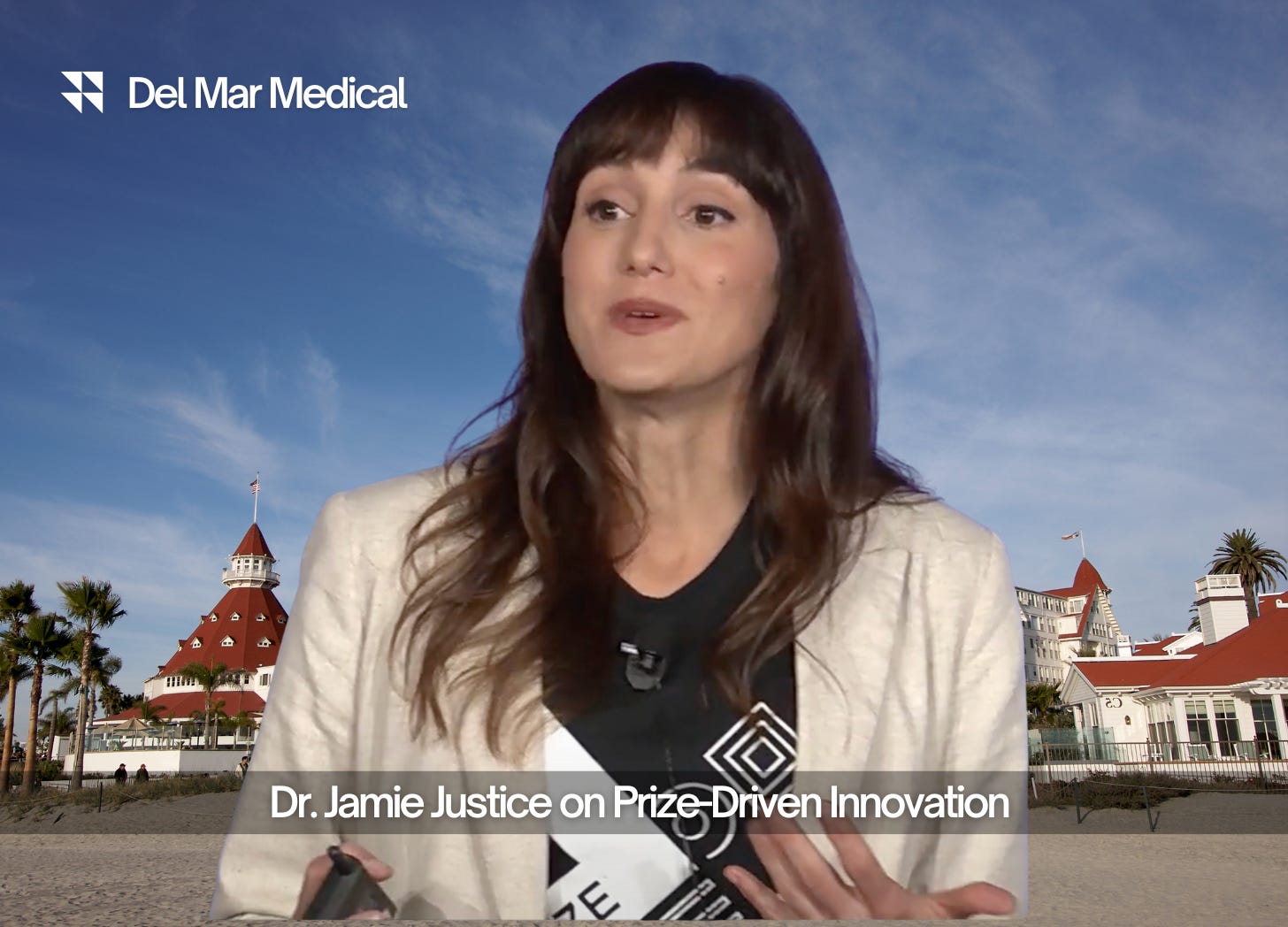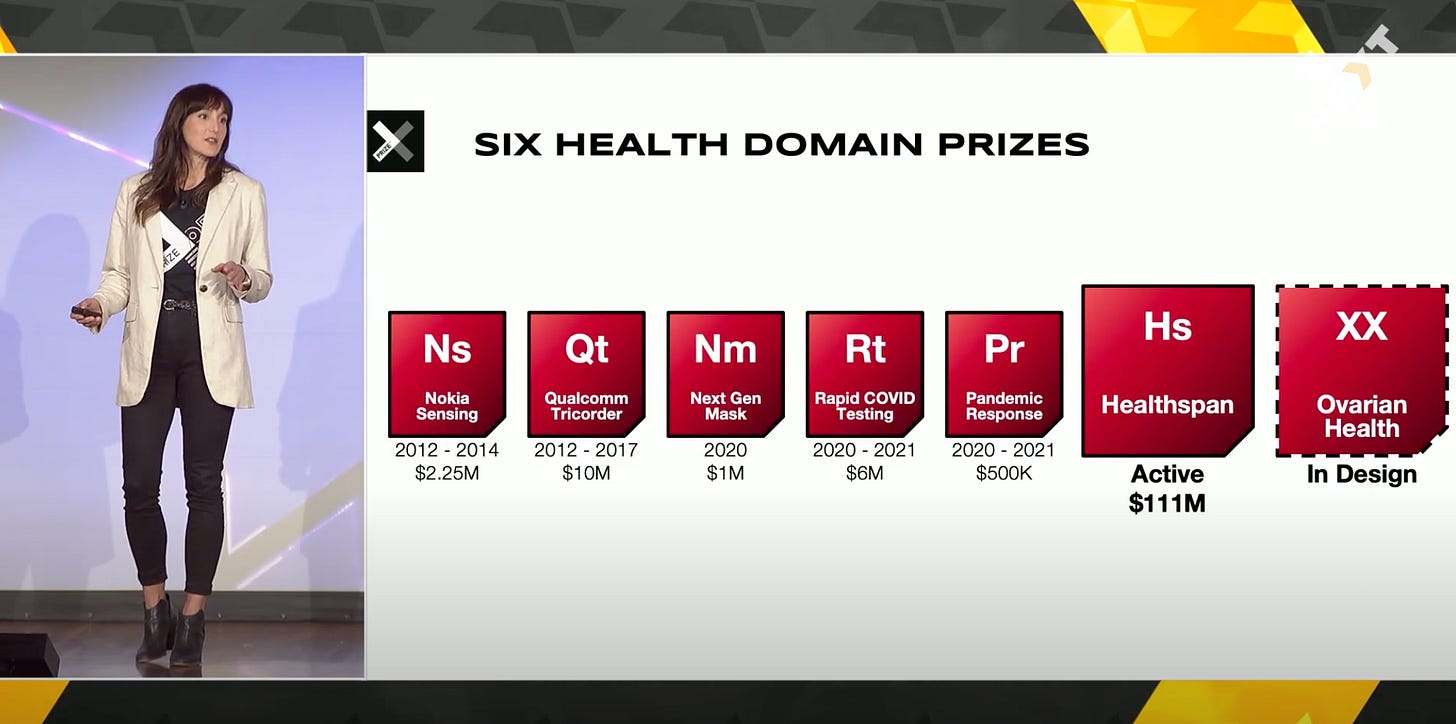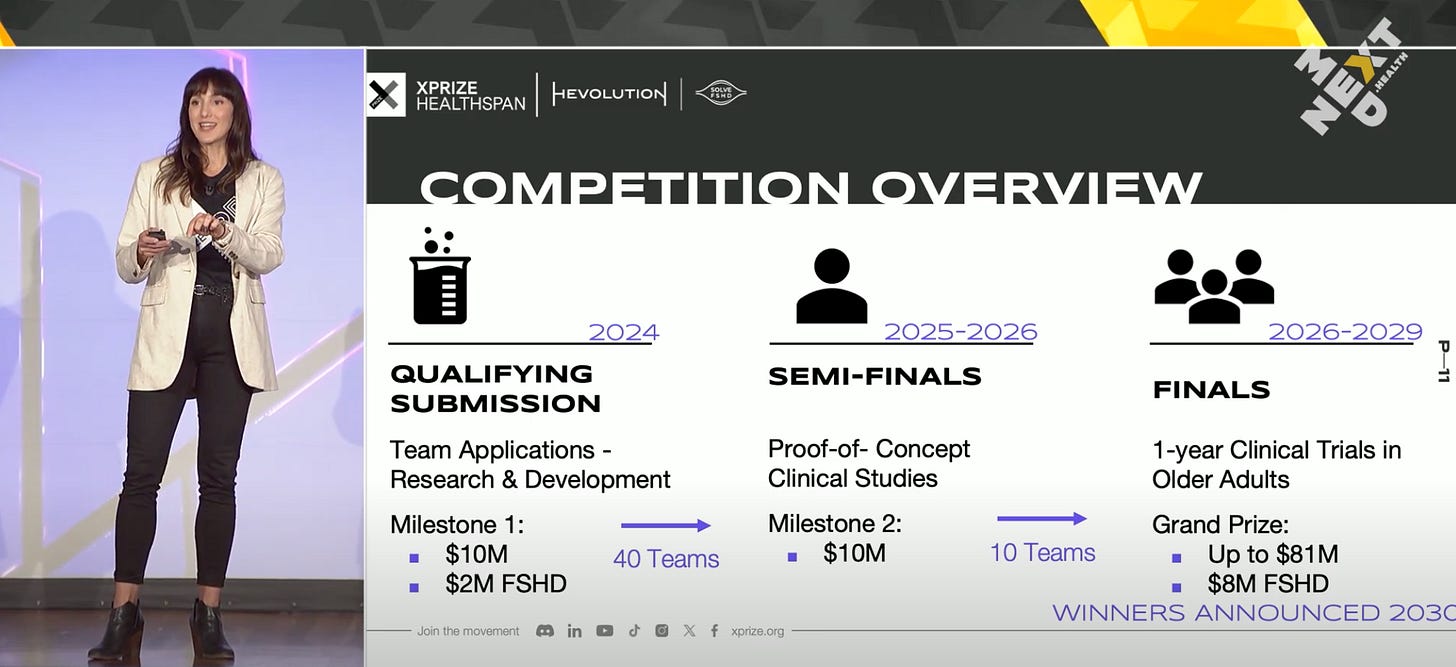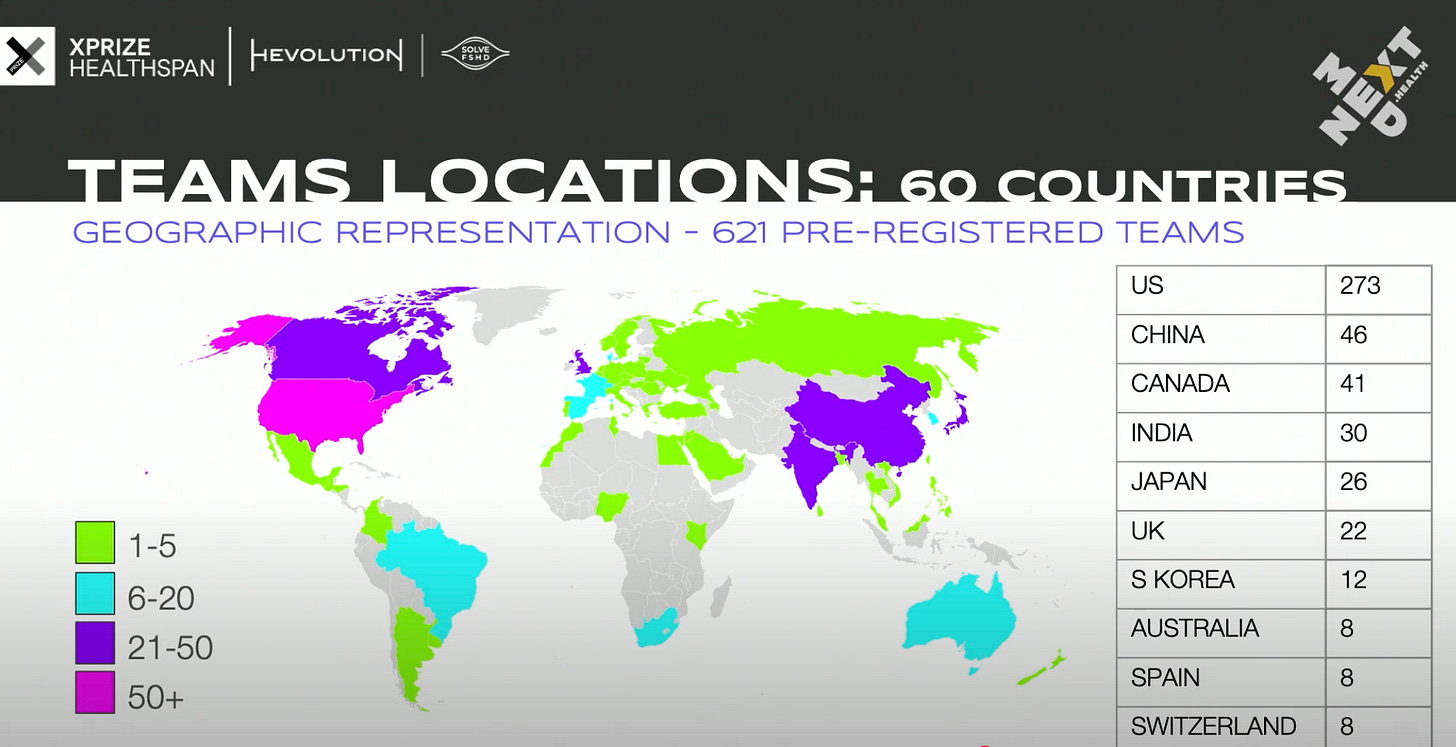Dr. Jamie Justice on Prize-Driven Innovation: Advancing Healthspan and Ovarian Health
At the recent NextMed conference in Coronado, Jamie Justice—Executive Director of the XPRIZE Healthspan and Executive Vice President for Health at the XPRIZE Foundation—delivered a powerful and inspiring talk on how incentivized competition can transform the future of aging and women’s health. Drawing from her academic background in geriatrics and gerontology at Wake Forest School of Medicine, Justice positioned the XPRIZE model not just as a philanthropic experiment, but as a force capable of reshaping biomedical research, regulation, and global collaboration.
"Dr. Jamie Justice was an absolute delight at the lunch table—brilliant, grounded, and generous with her insights," said Robert Mowry of Del Mar Medical. "I left the conversation inspired by all that she’s doing to elevate science and bring real-world momentum to longevity and women's health research."
I structured her talk into five major themes: the XPRIZE model, the global aging challenge, the Healthspan Prize, the promise of geroscience, and the future direction of XPRIZE in women’s health.
I. The XPRIZE Model: Competitive Philanthropy for Global Impact
Justice opened by reminding the audience of XPRIZE’s roots as a nonprofit foundation with over 30 years of history in designing and executing prize competitions that solve humanity’s grand challenges. To date, the foundation has launched 30 prizes spanning domains like space exploration, rainforest conservation, and carbon removal. The model is simple but effective: instead of funding research through traditional grants, XPRIZE offers a reward for achieving specific, high-impact outcomes. This “pay-for-success” strategy aligns incentives and encourages bold, interdisciplinary collaboration.
Health-related prizes are a growing focus, with six launched to date, including pandemic detection, cancer diagnostics, and now the ambitious Healthspan Prize. With a total purse of $111 million—including a $10 million bonus—this prize ranks among the most significant health innovation challenges in history.
II. Why Prize Health: Aging as the Defining Global Challenge
Justice centered her argument on the demographic reality that populations across the globe are aging at unprecedented rates. Contrary to popular framing, this is not inherently negative; more people living longer is a societal triumph. Yet longer lives bring challenges—particularly if additional years come with disability and disease.
In the U.S., she noted, life expectancy has increased by 30 years over the past century, but health-adjusted life expectancy has not kept pace. There’s a staggering 12-year gap between how long people live and how long they live in good health. Moreover, for those over 65, disability-adjusted life years have increased by 32%, signaling that many people spend their final decades in declining health.
Globally, these trends are mirrored in countries from Japan to Brazil. The systems we’ve built—clinical trials, drug regulation, disease classification—were not designed for the complexities of aging populations. Thus, the need for systemic innovation is not just medical, but political, social, and economic.
III. Healthspan XPRIZE: Redefining What’s Possible in Aging
The Healthspan Prize confronts this head-on. Its mission: identify therapeutics that demonstrably improve biological function in older adults. Rather than targeting one disease, the prize embraces the geroscience hypothesis—that aging itself is the root risk factor for most chronic diseases.
To win, teams must show improvement in three areas: muscle strength, immune function, and cognitive ability. The prize is outcome-driven, with different award tiers based on percentage improvement over a one-year clinical trial. A 10% improvement qualifies, but a 20% improvement hits the moonshot goal. Importantly, this isn't theoretical—teams must deliver real-world results in humans.
The prize timeline stretches to 2030, with multiple phases: registration, qualifying submission, semi-finals, finals, and final prize awarding. The first milestone, already completed, awarded $10 million to 40 teams that met the initial criteria. A judging summit for the FSHD (Facioscapulohumeral muscular dystrophy) prize was even occurring nearby during Justice’s talk.
Justice shared that over 600 teams from more than 60 countries registered, and nearly 190 teams submitted qualifying applications. This level of participation is proof that the prize model resonates globally. Teams come from every corner of the innovation ecosystem: startups, pharma giants, universities, nonprofits, and even student-led initiatives.
IV. The Science Behind the Prize: Geroscience as a Disruptive Framework
Justice highlighted her own academic work in the field of geroscience, a relatively new discipline that studies the biology of aging as a modifiable process. Rather than treating diabetes, heart disease, and Alzheimer's separately, geroscientists explore how aging mechanisms—like mitochondrial decline or inflammation—create shared risk across diseases.
In animal models, interventions such as senolytics (which clear aging cells) or mTOR inhibitors (which mimic caloric restriction) have extended both lifespan and healthspan. But the road to human application is blocked by poor public understanding, fragmented research silos, unclear regulatory frameworks, and limited clinical data.
This is where the Healthspan Prize becomes catalytic. By requiring clinical validation across domains, it pushes the field out of mice labs and into hospitals. It also forces engagement with regulators like the FDA, which historically haven’t recognized aging as a treatable condition. Justice suggested that the regulatory conversations sparked by XPRIZE submissions may accelerate the development of new approval pathways for aging-related therapies.
The diversity of proposed solutions is staggering: stem cells, extracellular vesicles, gene therapies, biologics, electrical stimulation devices, nutraceuticals, epigenetic reprogramming, and more. Each team must prove its intervention works in living humans—and that it works across multiple domains of decline.
As Justice put it: “It’s not about one disease, it’s about staying healthier, longer, across the board.”
V. Looking Ahead: The Double XX Prize and Women’s Health Equity
Justice ended her talk with a preview of XPRIZE’s next frontier: ovarian health. Dubbed the “Double XX Prize,” this upcoming competition will focus on promoting ovarian function across the lifespan—a critical and under-researched component of women’s health.
As emphasized by collaborators Jennifer Garrison and Daisy Robinson, ovaries are not just about reproduction; they are metabolically active organs that influence brain health, bone density, and immunity. Yet we have almost no tools to monitor or support their long-term function. There are no standard clinical metrics for ovarian aging, and menopause is often treated as a binary event rather than a slow, systemic change.
The XX Prize aims to change that. Still in the design phase, it promises to be XPRIZE’s most ambitious women’s health initiative yet. Just as the Healthspan Prize reframes aging as something modifiable, the XX Prize could recast ovarian health as a vital sign worth protecting and optimizing.
Conclusion: Competitions That Drive Global Health Breakthroughs
Justice’s talk at NextMed wasn’t just a report on prize mechanics—it was a rallying cry for rethinking how we fund, regulate, and incentivize health innovation. She showed how competition can unlock capital, galvanize scientific collaboration, and accelerate public-private partnerships in ways that traditional grantmaking and venture models often cannot.
By blending vision with urgency, XPRIZE is turning once-fringe ideas—like treating aging as a disease—into global conversations. The Healthspan Prize is already catalyzing a new generation of researchers, biotech founders, and clinicians to work on preventive and regenerative solutions. The Double XX Prize promises to do the same for ovarian and women’s health.
Justice closed with a simple but profound reminder: aging is a global triumph, but whether it becomes a crisis or a continued victory depends on how we invest our resources—and how bold we are in reimagining what’s possible. With XPRIZE at the helm, the future of health may be not just longer, but brighter.




